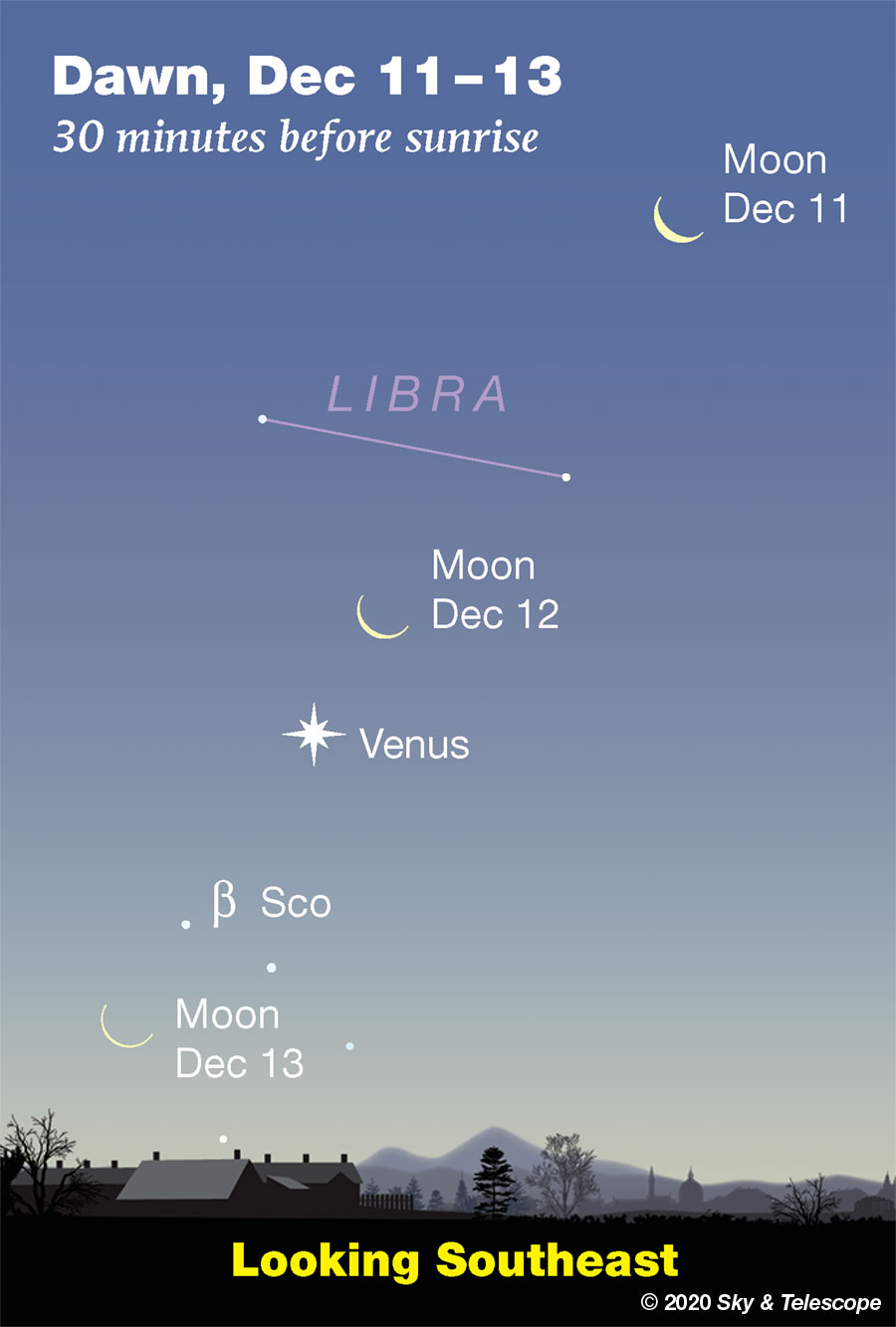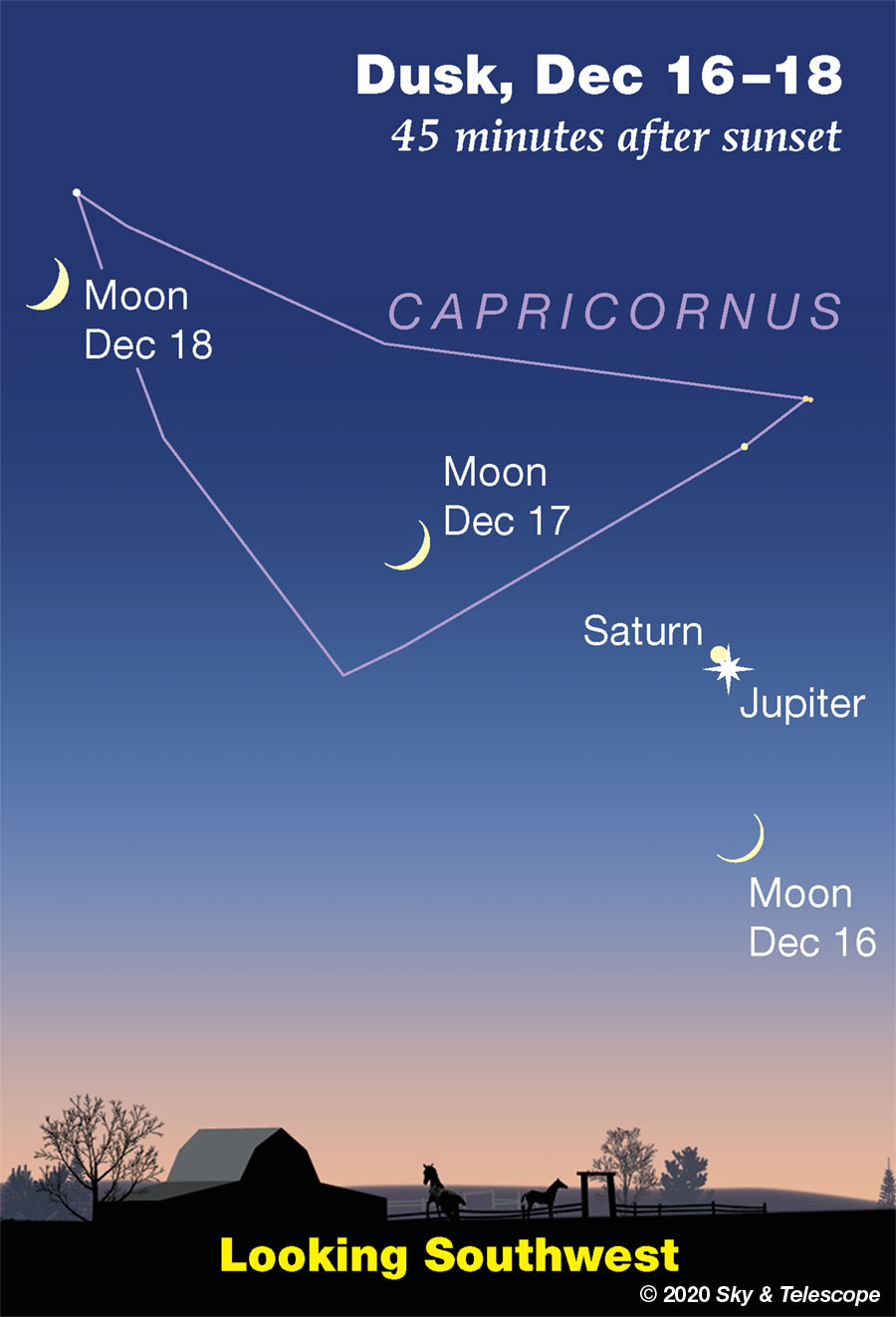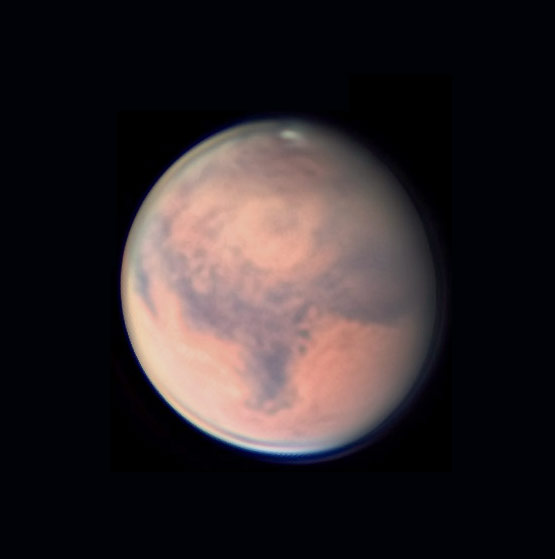FRIDAY, DECEMBER 11
■ Bright Jupiter and distant Saturn now shine strikingly close together in the southwestern sky at nightfall. This evening they're only 1.1° apart, about the width of a pencil held at arm's length. They're closing toward a mere 0.1° apart on December 21st. That's about the width of a toothpick at arm's length!
Watch their progress each evening. Already they'll fit together in the view of most telescope eyepieces at 40 power or less.
■ Seeing any Geminid meteors yet? The later you keep watch the better, preferably after midnight. The shower is due to reach its peak late Sunday night December 13-14; see below. And this year there's no Moon during the dark hours. See Bob King's A Banner Year for the Geminid Meteor Shower.
■ Moon and Venus at dawn. As day begins to break Saturday morning, look southeast for the thin crescent Moon with Venus some 4° or 5° to its lower left (for North America), as shown below.
Several hours later, the Moon will occult Venus in broad daylight for telescope users in the Pacific time zone. By then the Moon-Venus pair will be getting moderately low toward the southwest. Seen from Hawai`i the Moon and Venus will be higher in thinner, clearer daylit air (weather permitting) and should be easier to find. See the December Sky & Telescope, page 50.

SATURDAY, DECEMBER 12
■ Orion comes into view low in the east as early as dinnertime now. Look way down below the Pleiades and Aldebaran.
This also means Gemini is coming up to Orion's left (for the world's mid-northern latitudes). The head stars of the Gemini twins, Castor and Pollux, are at the far left end of the Gemini constellation — one over the other, with Castor on top.
SUNDAY, DECEMBER 13
■ The Geminid meteor shower should be at its strongest late tonight. And this year there's no moonlight to interfere with the view.
Early in the evening the meteors will be few, but the Geminids that do appear will be Earth-grazers skimming far across the top of the atmosphere. As the hours pass and the shower's radiant (near Castor in Gemini) rises higher in the east, the meteors will become shorter and more numerous — the most so from midnight to dawn.
Layer up even more warmly than you imagine you'll need; remember radiational cooling! Find a dark open spot with no local lights to get in your eyes, bring a reclining lawn chair, lie back and gaze up into the stars. Watch the darkest part of your sky, probably straight up. Be patient. As your eyes adapt to the dark, you may see a meteor every minute or two on average as night grows late.
For much more on the Geminids see the December Sky & Telescope, page 14, or Bob King's A Banner Year for the Geminid Meteor Shower online.
MONDAY, DECEMBER 14
■ This is the time of year when M31, the Andromeda Galaxy, passes your zenith in early evening (if you live in the mid-northern latitudes). The time depends on your longitude. Binoculars show M31 just off the knee of the Andromeda constellation's stick figure; see the middle of the big evening constellation chart in the center of the December Sky & Telescope.
■ New Moon (exact at 11:17 a.m. EST).
TUESDAY, DECEMBER 15
■ As the stars come out, the Cassiopeia W pattern stands on end (its fainter end) very high in the northeast. Watch Cas turn around to become a flattened M, higher in the north, later in the evening.
■ As Cassiopeia arches high after nightfall, the Big Dipper lies shyly down at its lowest position due north. It's entirely below the north horizon if you're as far south as Miami.
But by midnight the Dipper stands straight up on its handle in fine view in the northeast — while Cassiopeia has wheeled down to the northwest to again stand on end (this time its brighter end).
WEDNESDAY, DECEMBER 16
■ The big Summer Triangle is sinking lower in the west, and Altair is the first of its stars to go (for mid-northern skywatchers).
Start by spotting bright Vega, magnitude zero, in the northwest right after dark. The brightest star above Vega is Deneb. Altair, the Triangle's third star, is farther to Vega's left or lower left. How late into the night, and into the advancing season, can you keep Altair in view?

THURSDAY, DECEMBER 17
■ The little Pleiades cluster shines very high in the southeast after dinnertime, no bigger than your fingertip at arm's length. How many Pleiads can you count with your unaided eye? Take your time and keep looking. Most people can count 6. With sharp eyesight, a good dark sky, and a steady gaze, you may be able to make out 8 or 9.
FRIDAY, DECEMBER 18
■ Have you ever watched a Sirius-rise? Find an open view right down to the east-southeast horizon, and watch for Sirius to come up about two fists at arm's length below Orion's vertical three-star belt. Sirius rises sometime around 8 p.m. now depending on your location.
About 15 minutes before Sirius-rise, a lesser star comes up barely to the right of there. This is Beta Canis Majoris or Mirzam, a name that means “The Announcer.” What Mirzam announces is Sirius. You’re not likely to mistake them; the second-magnitude Announcer is only a twentieth as bright as the king of stars soon to make its royal entry.
When a star is very low it tends to twinkle slowly, and often in vivid colors. Sirius is bright enough to show these effects well, especially with binoculars.
SATURDAY, DECEMBER 19
■ Sirius and Procyon in the balance. Sirius, the Dog Star, sparkles low in the east-southeast after dinnertime. Procyon, the Little Dog Star, shines in the east about two fist-widths at arm's length to Sirius's left.
But directly left? That depends. If you live around latitude 30° (Tijuana, New Orleans, Jacksonville), the two canine stars will be at the same height above your horizon soon after they rise. If you're north of that latitude, Procyon will be higher. If you're south of there, Sirius will be the higher one. Your eastern horizon tilts differently with respect to the stars depending on your latitude.
This Week's Planet Roundup
Mercury is out of sight in conjunction with the Sun.
Venus (magnitude –3.9, near the head of Scorpius) shines low in the southeast during early dawn as the "Morning Star." As dawn advances, watch it climb higher as it fades into the growing daylight.
Mars (about magnitude –0.7, in Pisces) shines bright yellow-orange very high in the southern sky during evening. Mars is fading and shrinking into the distance, but it's still 13 or 12 arcseconds wide in a telescope, big enough to show surface detail during steady seeing. It's gibbous: 90% sunlit from Earth's point of view. Its recent dust storms seem to be over.

To get a map of the side of Mars facing you at the date and time you observe, you can use our Mars Profiler. The map there is square; remember to mentally wrap it onto the side of a globe. (Features near the map's edges become very foreshortened.)
Jupiter and Saturn (magnitudes –2.0 and +0.6, respectively) shine strikingly close together in the southwest during and after twilight. Jupiter is the bright one; Saturn is only one eleventh as bright. Their separation shrinks from 1.1° to 0.3° this week (December 11th to 18th), meaning they'll fit together in many telescopes' low-power field of view.
Don't expect to see much of any telescopic detail on them, what with the poor atmospheric seeing at their low altitude. But how many of their moons can you count? Identify the ones you see, and find where to look for the faint ones — and not mistake stars for moons — using our Jupiter's Moons and Saturn's Moons tools for your time and date.
Jupiter and Saturn will pass just 0.1° from each other at their conjunction on December 21st. That's about the width of a toothpick at arm's length. The two giants have conjunctions about every 20 years, but this will be their closest one that's been clearly visible (not too close to the Sun) since the year 1226.
Uranus (magnitude 5.7, in Aries) is high in the southeast after dark, about 16° east (left) of Mars. Uranus is only 3.7 arcseconds wide, but that's enough to appear as a tiny fuzzy ball, not a point, at high power in even a smallish telescope with sharp optics — during spells of good seeing.
Neptune (magnitude 7.9, in Aquarius) is nearly as high in early evening, over in the south-southwest. Neptune is 2.3 arcseconds wide, harder to resolve than Uranus except in very good seeing. Finder charts for Uranus and Neptune.
All descriptions that relate to your horizon — including the words up, down, right, and left — are written for the world's mid-northern latitudes. Descriptions that also depend on longitude (mainly Moon positions) are for North America.
Eastern Standard Time, EST, is Universal Time minus 5 hours. (Universal Time is also known as UT, UTC, GMT, or Z time.)
Want to become a better astronomer? Learn your way around the constellations. They're the key to locating everything fainter and deeper to hunt with binoculars or a telescope.
This is an outdoor nature hobby. For an easy-to-use constellation guide covering the whole evening sky, use the big monthly map in the center of each issue of Sky & Telescope, the essential magazine of astronomy.
Once you get a telescope, to put it to good use you'll need a detailed, large-scale sky atlas (set of charts). The basic standard is the Pocket Sky Atlas (in either the original or Jumbo Edition), which shows stars to magnitude 7.6.

Next up is the larger and deeper Sky Atlas 2000.0, plotting stars to magnitude 8.5; nearly three times as many. The next up, once you know your way around, are the even larger Interstellarum atlas (stars to magnitude 9.5) or Uranometria 2000.0 (stars to magnitude 9.75). And be sure to read how to use sky charts with a telescope.
You'll also want a good deep-sky guidebook, such as Sky Atlas 2000.0 Companion by Strong and Sinnott, or the bigger (and illustrated) Night Sky Observer's Guide by Kepple and Sanner.
Can a computerized telescope replace charts? Not for beginners, I don't think, and not on mounts and tripods that are less than top-quality mechanically, meaning heavy and expensive. And as Terence Dickinson and Alan Dyer say in their Backyard Astronomer's Guide, "A full appreciation of the universe cannot come without developing the skills to find things in the sky and understanding how the sky works. This knowledge comes only by spending time under the stars with star maps in hand."
![]() Audio sky tour. Out under the evening sky with your
Audio sky tour. Out under the evening sky with your
earbuds in place, listen to Kelly Beatty's monthly
podcast tour of the heavens above. It's free.
"The dangers of not thinking clearly are much greater now than ever before. It's not that there's something new in our way of thinking, it's that credulous and confused thinking can be much more lethal in ways it was never before."
— Carl Sagan, 1996
"Facts are stubborn things."
— John Adams, 1770
 7
7








Comments
Rod
December 11, 2020 at 7:26 am
Concerning Saturn and Jupiter conjunction coming, the report here said "Watch their progress each evening. Already they'll fit together in the view of most telescope eyepieces at 40 power or less."
I have been doing this and it is much fun and enjoyment 🙂 However, clouds moving in to my area now and perhaps some light snow early next week. I may be able to resume viewing Saturn and Jupiter using my 90-mm refractor telescope next week, perhaps Wednesday or Thursday. mary beth, new jersey eclipse fan, stay tuned :)---Rod
You must be logged in to post a comment.
Rod
December 11, 2020 at 7:16 pm
FYI. I was able to view again tonight Saturn and Jupiter from my fields. [Observed 1700-1800 EST. 2200-2300 UT. Sunset 1645 EST/2145 UT. Some great views of Saturn and Jupiter tonight using 32-mm plossl and 90-mm refractor. True FOV about 1.5-degrees across at 31x. Both planets fit nicely in the field of view. By 1740 EST, I could see various faint stars in Sagittarius near Saturn, Titan, Jupiter, and the 4 Galilean moons. Jupiter NEB and SEB clouds visible. The view tonight would make a great photo, especially with stars in the field, Saturn, rings, Titan, Jupiter (cloud belts) and the 4 Galilean moons.]
You must be logged in to post a comment.
New Jersey Eclipse Fan
December 12, 2020 at 9:31 pm
Thanks for the reports; I will indeed stay tuned!
You must be logged in to post a comment.
Rod
December 13, 2020 at 6:54 pm
New Jersey Eclipse Fan et al. I enjoyed another one hour viewing session this evening shortly after sunset of Saturn and Jupiter. Here is a note from my log. [Observed 1645-1745 EST/2145-2245 UT. Sunset near 1645 EST/2145 UT. Some good views tonight of Saturn and Jupiter closing for 21-Dec conjunction. 10x50 binoculars worked well too. I used the 25-mm plossl eyepiece tonight for 40x views, true FOV ~ 78 arcminute. The planets tonight ~ 52 arcminute angular separation according to Starry Night Pro Plus 8. Cirrus clouds did obscure at times and altocumulus too but there were moments of good seeing. Near 1730 EST/2230 UT, Rhea popped into view near Saturn and rings as well as Titan, more distinct. 3 Galilean moons visible on one side of Jupiter, Ganymede farther out. Using binoculars and the telescope makes for some enjoyable moments as I track this conjunction taking place in the sky. So tonight I could see Saturn, rings, Titan, at times Rhea, Jupiter cloud belts distinct and the 4 Galilean moons. I observed 6 moons in the solar system tonight, two at Saturn and 4 at Jupiter. At 40x, Saturn looks better in detail. As the angular separation between Saturn and Jupiter continues to get smaller, I can increase the power for better viewing of the planets. At 1700 EST/2200 UT, I could see Saturn with rings and Jupiter using the telescope. As the sky continued to darken, more detail and moons became visible, cloud belts on Jupiter too. As I viewed, I pondered the different distances of Jupiter and Saturn tonight from Earth in the eyepiece and how small I am in comparison 🙂 A flock of geese flew over me in my pasture, low and the leader was honking. I started honking, and we all enjoyed a honking good time. Other geese started participating in the honk activity too :)]
You must be logged in to post a comment.
mary beth
December 15, 2020 at 11:14 pm
Rod, NJEF, hope you both are going to have clear skies for the big event, So far things look pretty good here in Texas. It’s been cloudy and rainy the last three days but I’d rather get the rain over with now and hopefully have a beautiful solstice/conjunction and also a nice Christmas! Rod, I figured the geese might already be further south by now but I guess they like hanging out at your ‘planetarium’!
You must be logged in to post a comment.
Rod
December 16, 2020 at 9:09 am
FYI. I was out yesterday evening shortly after sunset until 1730 EST. Using my 14-mm eyepiece with true field about 60 arcminute, I could comfortably place Jupiter and Saturn in the field and see both at 71x. Good views but cirrus moving in caused some problems. I am tracking this closing pair since 07-Dec now. Today I have snow moving into my area 🙂 Because of the thickening cirrus when I observed last night, I could see only two Galilean moons and none at Saturn but Saturn at 71x, better viewing, Jupiter too with more cloud belts visible. When I came in yesterday evening, the wood burning stove sure felt good 🙂
You must be logged in to post a comment.
mary beth
December 16, 2020 at 11:39 pm
I hope everyone got to see the beautiful little crescent moon below the Saturn and Jupiter conjunction. Stunning!!
You must be logged in to post a comment.
You must be logged in to post a comment.